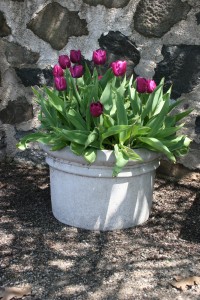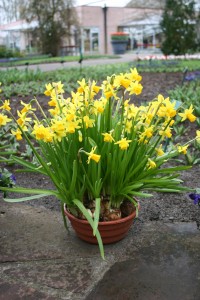Bulbs in Pots: A “One Hit Wonder” or A Lasting Treasure?
I’ve received lots of inquiries lately regarding bulbs planted in pots. We’ve all seen it: the gorgeous pots of hyacinths, tulips, and daffodils in full bloom sold at the local supermarket. If you’re anything like me, you’ve probably purchased one (or at least thought about it) and triumphantly brought your little piece of spring home with you. We are all anxious for spring and who wouldn’t want a little reminder that it will one day indeed come?
So you’ve brought home the pot of adorable miniature daffodils or extremely fragrant hyacinth or maybe you’ve signed up to receive a potted Easter Lily at church and they produced gorgeous blooms for a week or two. But now what do do with these beautiful indoor bulbs after flowering? Was the money you spent on this pot of once-blooming flowers wasted? Is there nothing left to do but dispose of the pot along with the bulbs just as though it were a fresh floral arrangement? Absolutely NOT! Why not replant the bulbs in your garden or another pot to enjoy for years to come?
What to Do with Bulbs in Pots after Flowering
- Once the plant has stopped blooming, discontinue watering and allow the foliage to die back.
- Once the foliage is dried and brown, remove it from the pot by gently tugging on the leaves until they break from the bulb and come out of the ground. If the leaves do not pull away from the bulbs easily wait a bit longer. It is important to not remove the foliage prematurely. The foliage helps to put energy back in the bulbs for the next year’s blooms.
- Remove the bulbs from the dirt and dust them off. Check for any rotten or soft spots on bulbs. If these spots are visible on any bulbs, discard them. Allow the bulbs dry out on a piece of paper. A cool, dry, and dark place is ideal for drying and storing the bulbs. Alternatively, you can plant the bulbs directly in the ground if the weather is suitable for planting.
Bulbs in Pots Hardiness Zones 3-8

If you live in Hardiness Zones 3 – 8 the bulbs can be replanted in your outdoor garden in fall. Planting can happen anytime between late September and November.
Bulbs in Pots Hardiness Zones 8 and Above
If you live south of Hardiness Zone 8 you will need to “pre-chill” these bulbs in October or November. Pre-chill by placing them into your refrigerator in a brown paper bag for a period of 10-12 weeks. Read more about pre-chilling and forcing flower bulbs in our Flower Bulb and Forcing 101 article. Once the bulbs have chilled for the correct period and may even have started to sprout, they are ready to be replanted either in the outdoors or in a pot!
IMPORTANT TO REMEMBER: The process of artificially chilling bulbs and then forcing them to bloom early takes quite a bit of energy from the bulb. Therefore, you may not see blooms for the next few springs. Be patient: once the bulb stores up enough energy, it’ll be beautiful once again!
So the next time you pass the floral counter at the grocery store or hear of an offer to order some potted bulbs for Easter, don’t hesitate to pick one up for yourself! Remember, spring planting bulbs work great for this, too! Good luck to you!
Want to learn more about planting bulbs in pots? Email Jenny at jenny@bulbblog.com. Your question may even be featured in a future blog post!



